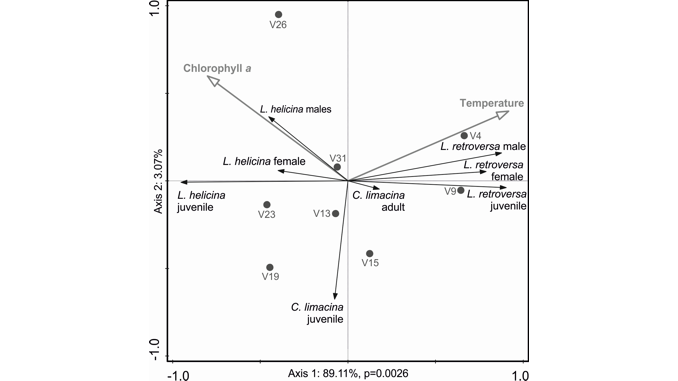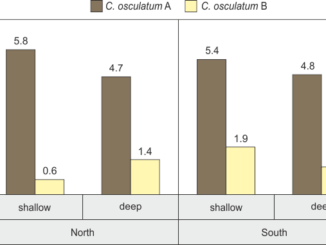
Paper category: Original research paper
Corresponding author: Paula Kacprzak (paula.kacprzak@phdstud.ug.edu.pl)
DOI: 10.1515/ohs-2017-0039
Received: January 2, 2017
Accepted: July 3, 2017
Full text: here
Citation (APA style):
Abstract
The abundance and horizontal distribution of three pteropod species, Limacina helicina, Limacina retroversa and Clione limacina were examined in the western entrance of the Barents Sea (Polar Front region) in August 2011. Sixteen samples were collected from 8 sampling sites located along a latitudinal transect. The southern part of the study area (south of 73°N) was dominated by L. retroversa, while L. helicina was mostly observed north of 73°N. Surface water temperature differences between the coldest and the warmest station were around 8°C. The highest density of L. retroversa was found in the south, near the Norwegian coast (nearly 52 000 ind. 1000 m-3), while the highest density of L. helicina was observed in the region of the Arctic water masses (nearly 13 000 ind. 1000 m-3). The sampled population of pteropods comprised mainly juvenile stages. Redundancy analysis (RDA) of the relationships between environmental factors (mean and surface salinity, mean temperature, sampling depth, chlorophyll concentration) and the population structure showed that mean temperature was the most important factor in the study area, explaining 70.5% of the pteropod community variation.
References
Bainbridge, V. & McKay, B.J. (1968). The feeding of cod and redfish larvae. Int. Comm. Nothwest Atl. Fisheries, Spec. Publ. No. 7. Environmental surveys – Norwestlant 1- 3, 1963. Part I: 187-217.
Bathmann, U.V., Noji, T.T. & Von Bodungen, B. (1991). Sedimentation of pteropods in the Norwegian Sea in autumn. Deep Sea Research 38(10): 1341-1360. DOI: 10.1016/0198-0149(91)90031-A.
Bauerfeind, E., Nöthig, E.-M., Pauls, B., Kraft, A. & Beszczyńska- Möller, A. (2014). Variability in pteropod sedimentation and corresponding aragonite flux at the Arctic deep-sea long-term observatory HAUSGARTEN in the eastern Fram Strait from 2000 to 2009. Journal of Marine Systems 132: 95-105. DOI: 10.1016/j.jmarsys.2013.12.006.
Bednarsek, N., Mozina, J., Vogt, M., O’Brien, C. & Tarling, G.A. (2012a). The global distribution of pteropods and their contribution to carbonate and carbon biomass in the modern ocean. Earth System Science Data 4(1): 167-186. DOI: 10.5194/essd-4-167-2012.
Bednarsek, N., Tarling, G.A., Fielding, S., Bakker, D.C.E. (2012b). Population dynamics biogeochemical significance of Limacina helicina antarctica in the Scotia Sea (Southern Ocean). Deep-Sea Research II 59-60: 105-116. DOI: 10.1016/j.dsr2.2011.08.003.
Bernard, K.S. & Froneman, P.W. (2009). The sub-Antarctic euthecosome pteropod, Limacina retroversa: Distribution patterns and trophic role. Deep Sea Research I 56: 582-598. DOI: 10.1016/j.dsr.2008.11.007.
Bluhm, B.A., Iken, K., Mincks Hardy, S., Sirenko, B.I. & Holladay, B.A. (2009). Community structure of epibenthic megafauna in the Chukchi Sea. Aquatic Biology. 7: 269-93 DOI: 10.3354/ab00198.
Busch, K., Bauerfeind, E. & Nöthig, E.- M. (2015). Pteropod sedimentation patterns in different water depths observed with moored sediment traps over a 4-year period at the LTER station HAUSGARTEN in eastern Fram Strait. Polar Biology 38: 845-859. DOI: 10.1007/s00300-015-1644-9.
Cheung, W.W.L., Lam, V.W.Y., Sarmiento, J.L., Kearney, K., Watson, R. et al. (2009). Projecting global marine biodiversity impacts under climate change scenarios. Fish and fisheries 10(3): 235-251. DOI: 10.1111/j.1467-2979.2008.00315.x.
Comeau, S., Gorsky, G., Jeffree, R., Teyssie, J.L. & Gatusso, J.P. (2009). Impact of ocean acidification on a key Arctic pelagic mollusc (Limacina helicina). Biogeosciences 6: 1877-1882. DOI: 10.5194/bg-6-1877-2009.
Conover, R.J. & Lalli, C.M. (1972). Feeding and growth in Clione limacina (Phipps), a pteropod mollusc. Journal of Experimental Marine Biology and Ecology 9(3): 279-302. DOI: 10.1016/0022-0981(72)90038-X.
Cottier, F.R., Tverberg, V., Inall, M.E., Svendsen, H., Nilsen, F. et al. (2005). Water mass modification in an Arctic fjord through cross-shelf exchange: the seasonal hydrography of Kongsfjord, Svalbard. Journal of Geophysical Research 110(C12): 1-18. DOI: 10.1029/2004JC002757.
Dadon, J.R. & de Cidre, L.L. (1992). The reproductive cycle of of the Thecosomatous pteropod Limacina retroversa in the western South Atlantic. Marine Biology 114: 439-442.
Dadon, J.R. & Chauvin, S.F. (1998). Distribution and abundance of Gymnosomata (Gastropoda: Opisthobranchia) in the Southwest Atlantic. Journal Molluscan Studies 64(3): 345- 354. DOI: 10.1093/mollus/64.3.345.
Doney, S.C., Ruckelshaus, M., Duffy Emmett, J., Barry, J.P., Chan, F. et al. (2012). Climate change impacts on marine ecosystems. Annual Review of Marine Sciences 4: 11-37. DOI:
10.1146/annurev-marine-041911-111611.
Fabry, V.J., Seibel, B.A., Feely, R.A. & Orr, J.C. (2008). Impacts of ocean acidification on marine fauna and ecosystem processes. Journal of Marine Science 65(3): 414-432. DOI: 10.1093/icesjms/fsn048.
Gannefors, C., Boer, M., Kattner, G., Graeve, M., Eiane, K. et al. (2005). The Arctic sea butterfly Limacina helicina: lipids and life strategy. Marine Biology 147(1): 169-177. DOI: 10.1007/s00227-004-1544-y.
Gilmer, R.W. & Harbison, G.R. (1986). Morphology and field behavior of pteropod molluscs: feeding methods in the families Cavoliniidae, Limacinidae and Peraclididae (Gastropoda: Thecosomata). Marine Biology 91(1): 47-57. DOI: 10.1007/BF00397570.
Gilmer, R.W. & Harbison, G.R. (1991). Diet of Limacina helicina (Gastropoda: Thecosomata) in Arctic waters in midsummer. Marine Ecology Progress Series 77(2-3): 125-134. DOI: 10.3354/meps077125.
Grebmeier, J.M. (2012). Shifting patterns of life in the Pacific Arctic and Sub-Arctic Seas. Annual Review of Marine Science 4: 63-78. DOI: 10.1146/annurev-marine-120710-100926.
Hardy, A.C. (1924). The herring in relation to its animate environment. Part I. The food and feeding habits of the herring with special reference to the East Coast of England. Fishery Invest., London 2(3): 1-53.
Hisdal, V. (1998). Svalbard. Nature and history. Oslo: Norsk Polarinstitutt.
Hop, H., Pearson, T., Hegseth, E.N., Kovacs, K.M., Wiencke, C. et al. (2002). The marine ecosystem of Kongsfjorden, Svalbard. Polar Research 21: 167-208. DOI: 10.1111/j.1751-8369.2002.tb00073.x.
Howard, W.R., Roberts, D., Moy, A.D., Lindsay, M.C.M., Hopcroft, R.R. et al. (2011). Distribution, abundance and seasonal flux of pteropods in the Sub-Antarctic Zone. Deep Sea Research II 58: 2293-2300. DOI: 10.1016/j.dsr2.2011.05.031.
Hsiao, S.C.T. (1939). The reproduction of Limacina retroversa (Flem.). Biol. Bull. Mar. biol. Lab., Woods Hole 76: 280-303.
Intergovernmental Panel on Climate Change (IPCC). (2001). Climate Change 2000 –Third Assessment Report. Cambridge: Cambridge University Press.
Ito, J. (1964). Food and feeding habit of Pacific salmon (genus Oncorhynchus) in their oceanic life. Bull. Hokkaido reg. Fish. Res. Lab. 29: 85-97.
Johannessen, O.M., Bengtsson, L., Miles, M.W., Kuzmina, S.I., Semenov, V. et al. (2004). Arctic climate change: observed and modelled temperature and sea – ice variability. Tellus 56(4): 328-341. DOI: 10.1111/j.1600-0870.2004.00060.x.
Karnovsky, N.J., Węsławski, J.M., Kwaśniewski, S., Walkusz, W. & Beszczyńska-Möller, A. (2003). Foraging behavior of little auks in heterogeneous environment. Marine Ecology Progress Series 253: 289-303. DOI: 10.3354/meps253289.
Kobayashi, H.A. (1974). Growth cycle and related vertical distribution of the thecosomatous pteropod Spiratella (“Limacina”) helicina in the central Arctic Ocean. Marine Biology 26(4): 295-301. DOI: 10.1007/BF00391513.
Lalli, C.M. & Wells F.E. (1978). Reproduction in the genus Limacina (Opisthobranchia: Thecosomata). Journal of Zoology: Proceedings of the Zoological Society of London 186(1): 95-105. DOI: 10.1111/j.1469-7998.1978.tb03359.x.
Lalli, C.M. & Gilmer, R.W. (1989). Pelagic snails. The Biology of Holoplanktonic Gastropod Mollusks. California: Stanford University Press.
Larson, R.J. & Harbison, G.R. (1989). Source and fate of lipids in polar gelatinous zooplankton. Arctic 42: 339-346.
Lebour, M.V. (1932). Limacina retroversa in Plymouth waters. Journal of Marine Biology Association U.K. 18: 123-129. DOI: 10.1017/S0025315400051341.
Loeng, H. (1991). Features of the oceanographic conditions of the Barents Sea. Polar Research 10(1): 5-18. DOI: 10.1111/j.1751-8369.1991.tb00630.x.
Loeng, H., Ozhigin, V. & Adlandsvik, B. (1997). Water fluxes through the Barents Sea. ICES Journal of Marine Sciences 54(3): 310-317. DOI: 10.1006/jmsc.1996.0165.
Mileykovsky, S.A. (1970). Breeding and larval distribution of the pteropod Clione limacina in the North Atlantic, Subarctic and North Pacific Oceans. Marine Biology 6(4): 317-334. DOI: 10.1007/BF00353665.
Mucci, A. (1983). The solubility of calcite and aragonite in seawater at various salinities, temperatures and one atmosphere total pressure. American Journal of Science 289: 780-799. DOI: 10.2475/ajs.283.7.780.
NASA Goddard Space Flight Center, Ocean Ecology Laboratory, Ocean Biology Processing Group. Sea-viewing Wide Field-of-view Sensor (SeaWiFS) Ocean Color Data; 2014 Reprocessing. NASA OB.DAAC, Greenbelt, MD, USA. DOI: 10.5067/ORBVIEW-2/SEAWIFS_OC.2014.0.
Phipps, C.J. (1774). A voyage towards the North Pole. London: Bowyer and Nichols. DOI: 10.1017/CBO9781107256323.
Piechura, J., Beszczyńska-Möller, A. & Osiński, R. (2001). Volume, heat and salt transport by the West Spitsbergen Current. Polar Research 20: 233-240. DOI: 10.1111/j.1751-8369.2001.tb00061.x.
Reygondeau, G., Longhurst, A., Martinez, E., Beaugrand, G., Antoine, D. et al. (2013). Dynamic biogeochemical provinces in the global ocean. Global Biogeochemical Cycles 27(4): 1046-1058. DOI: 10.1002/gbc.20089.
Richardson, A.J. (2008). In hot water: zooplankton and climate change. Journal of Marine Science 65: 279-295. DOI: 10.1093/icesjms/fsn028.
Roberts, D., Howard, W.R., Roberts, J.L., Bray, S.G., Moy, A.D. et al. (2014). Diverse trends in shell weight of three Southern Ocean pteropod taxa collected with Polar Frontal Zone sediment traps from 1997-2007. Polar Biology 37: 1445-1458. DOI: 10.1007/s00300-014-1534-6.
Sakshaug, E., Bjorge, A., Gulliksen, B., Loeng, H. & Mehlum, F. (1994). Structure, biomass distribution, and energetics of the pelagic ecosystem in the Barents Sea: A synopsis. Polar Biology 14: 405-411. DOI: 10.1007/BF00240261.
Sakshaug, E. (1997). Biomass and productivity distributions and their variability in the Barents Sea. ICES Journal of Marine Sciences 54(3): 341-350. DOI: 10.1006/jmsc.1996.0170.
Saloranta, T. & Svendsen, H. (2001). Across the Arctic front west of Spitsbergen: high resolution CTD sections from 1998-2000. Polar Research 20: 177-184. DOI: 10.1111/j.1751-8369.2001.tb00054.x.
Ter Braak, C.J.F. & Prentice I.C. (1988). A Theory of Gradient Analysis. Advances in Ecological Research 18: 271-317. DOI: 10.1016/S0065-2504(08)60183-X.
Ter Braak, C.J.F. & Šmilauer, P. (2012). Canoco reference manual and user’s guide: software for ordination, version 5.0. USA, Ithaca: Microcomputer Power.
Thabet, A.A., Maas, A.E., Lawson, G.L., Tarrant, A.M. (2015). Life cycle and early development of the thecosomatous pteropod Limacina retroversa in the Gulf of Maine, including the effect of elevated CO2 levels. Marine Biology 162: 2235-2249.
Van Der Spoel, S. (1967). Euthecosomata, a Group with remarkable Developmental Stages (Gastropoda, Pteropoda). Gorinchem: J. Noorduijn.
Van Der Spoel, S. (1976). Pseudothecosomata, Gymnosomata and Heteropoda (Gastropoda). Utrecht: Bohn, Scheltema, and Holkema.
Walczowski, W., Piechura, J., Goszczko, I. & Wieczorek, P. (2012). Changes in Atlantic water properties: an important factor of the European Arctic marine climate. ICES Journal of Marine Science 69(5): 864-869. DOI: 10.1093/icesjms/fss068.
Walczowski, W. (2013). Frontal structures in the West Spitsbergen Currents margins. Ocean Science 9: 957-975. DOI: 10.5194/os-9-957-2013.
Walkusz, W., Kwaśniewski, S., Falk-Petersen, S., Hop, H., Tverberg, V. et al. (2009). Seasonal and spatial changes in the zooplankton community of Kongsfjorden, Svalbard. Polar Research 28(2): 254-281. DOI: 10.1111/j.1751-8369.2009.00107.x.
Weydmann, A., Søreide, J.E., Kwaśniewski, S., Leu, E., Falk-Petersen, S. et al. (2013). Ice-related seasonality in zooplankton community composition in a high Arctic fjord. Journal of Plankton Research 35: 831-842. DOI: 10.1093/plankt/fbt031.
Weydmann, A., Carstensen, J., Goszczko, I., Dmoch, K., Olszewska, A. et al. (2014). Shift towards the dominance of boreal species in the Arctic: inter-annual and spatial zooplankton variability in the West Spitsbergen Current. Marine Ecology Progress Series 501: 41-52. DOI: 10.3354/meps10694.
Węsławski, J.M., Pedersen, G., Falk-Petersen, S. & Poraziński, K. (2000). Entrapment of macroplankton in an Arctic fjord basin, Kongsfjorden, Svalbard. Oceanologia 42(1): 57-69.


Bądź pierwszy, który skomentuje ten wpis